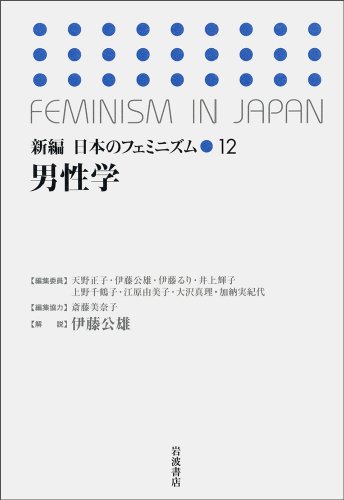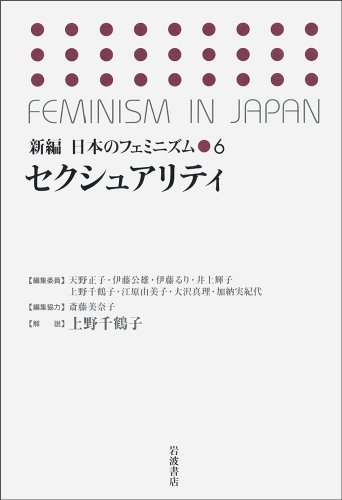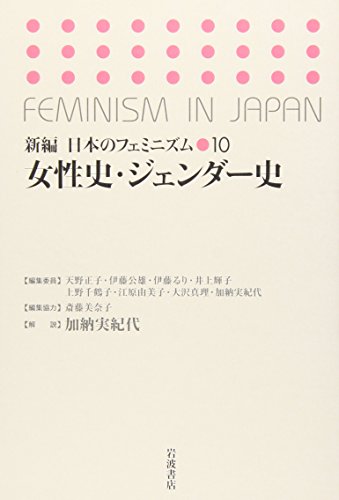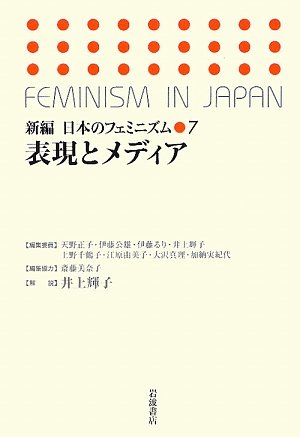8 0 0 0 男性学
- 著者
- 天野正子 [ほか] 編集委員 斎藤美奈子編集協力 伊藤公雄解説
- 出版者
- 岩波書店
- 巻号頁・発行日
- 2009
6 0 0 0 セクシュアリティ
- 著者
- 天野正子 [ほか] 編集委員 斎藤美奈子編集協力 上野千鶴子解説
- 出版者
- 岩波書店
- 巻号頁・発行日
- 2009
2 0 0 0 女性史・ジェンダー史
- 著者
- 天野正子 [ほか] 編集委員 斎藤美奈子編集協力 加納実紀代解説
- 出版者
- 岩波書店
- 巻号頁・発行日
- 2009
2 0 0 0 リブとフェミニズム
- 著者
- 天野正子 [ほか] 編集委員 斎藤美奈子編集協力 上野千鶴子解説
- 出版者
- 岩波書店
- 巻号頁・発行日
- 2009
1 0 0 0 OA 看護婦の労働と意識
- 著者
- 天野 正子
- 出版者
- The Japan Sociological Society
- 雑誌
- 社会学評論 (ISSN:00215414)
- 巻号頁・発行日
- vol.22, no.3, pp.30-49, 1972-01-30 (Released:2009-11-11)
- 参考文献数
- 5
- 被引用文献数
- 10 2
The main purpose of this article is to elucidate the process by which the occupations in the modern society are professionalized, through a case study of the nurse in Japan. The nurse is still considered as a semi-profession in Japan. Why is it ? In conclusion, it is due to the fact that there still remains a big distance between the nurse and “full-fledged professions” in that the nurse lack autonomy or a wide range of freedom as individuals and groups' and speciality to guarantee the autonomy or a system of highly professionalized knowledge and technology, both of which constitute a basic requirement of professions. In other words, the central questions in professionalization of the nurse are : firstly, how to establish their “speciality” based on the systematized knowledge and technology, and secondly, how to free themselves from subordination to medical doctors amidst the rapidly bureaucratizing organization of hospitals and thus to establish their “speciality”. The answers to these two questions have so far been sought in the improvement of training and certification system of the nurse and in the movements for obtaining rights as laborers. This article, however, intends to examine the structure of attitudes and opinion of nurses toward the situations and meaning of the occupation in which they are engaged, as a preliminary task before attempting to identify the tendency toward professionalization in the policy or in the movement. It seems essential if we are to consider the possibility that the nurse may be professionalized. The survey used in this paper was administered to 296 nurses holding certificates under the new system in seven hospitals in Tokyo. Contrasting the results of this survey, I also used parts of the results of the survey administered to 246 students in their final year enrolled in nine nursing junior colleges or higher institutes. The following points have been revealed by the surveys : Reflected strongly in the opinion and attitude of nurses are the difficult situations for the professionalization such as unsatisfactory system and content of education, immature science of nursing, subordinate relation to medical doctors, gap between what they are originally expected to do and what they are actually doing, and weak Japan Nursing Association, which should play a central role in the efforts toward the professionalization of the nurse. This fact implies that the nurse has not yet reached even the level of semi-profession, the typical example of which are the elementary and lower secondary school teacher. In spite of this low level of professionalization, they are quite satisfied with the present level of specialization and autonomy and optimistic about the future of their occupation. The nurse still remains to establish itself as a semi-profession. Its full-fledged professionalization will begin when it has attained speciality and autonomy as a semi-profession. But, it is quite dubious if they will show the confidence and optimistic perspectives about the level of professionalization of their occupation and its future possibility as they do today, even when they have established as a semi-profession.
- 著者
- 天野 正子
- 出版者
- 金城学院大学
- 雑誌
- 金城学院大学論集 (ISSN:04538862)
- 巻号頁・発行日
- no.105, pp.p71-108, 1983
1 0 0 0 表現とメディア
- 著者
- 天野正子 [ほか] 編集委員 斎藤美奈子編集協力 井上輝子解説
- 出版者
- 岩波書店
- 巻号頁・発行日
- 2009
1 0 0 0 OA 第一次大戦後における女子高等教育の社会的機能
- 著者
- 天野 正子
- 出版者
- 日本教育社会学会
- 雑誌
- 教育社会学研究 (ISSN:03873145)
- 巻号頁・発行日
- vol.33, pp.118-131,en218, 1978-09-30 (Released:2011-03-18)
This study deals with the period between 1920 and the time Japan undertook a wartime posture in 1935-during this period higher education for women indicated a singular increase in facilities and enrollment.In considering why higher education for women showed so singular a quantitative development during this period, there is an explanation (diagrammatic explanation) that points to the prosperous situation of the economy following World War I, which brought about a change in the industrial and social structures-notably the development of the middle class-a change that entailed the “push” of arapid rise in the demand for further education and, simultaneously, the “pull” of a growing social demand for the graduates of higher education. This explanation is validated by many scholars. However, there is little mention about the specific meanings of “push” and “pull”, their organic unification and the specific mechanisms which led to their quantitative increase. Moreover, there are only few studies in support of such an explanation.In this paper, therefore, I will scrutinize the process of development in higher education for women during the post WWI period, and the vectors of the “push” and the “pull” at work in this development-with particular attention to the following: 1) Structural characteristics of higher education for women;2) The demographic (social) status of the entrants into higher education;3) The occupational distribution of the graduates of higher education.
1 0 0 0 IR 専門職化をめぐる教師の意識構造について
- 著者
- 天野 正子 Amano Masako 東京教育大学大学院 Graduate School Tokyo University of Education
- 出版者
- 東洋館
- 雑誌
- 教育社会学研究 = The journal of educational sociology (ISSN:03873145)
- 巻号頁・発行日
- vol.24, pp.140-157, 1969-10-10
This article aims to grasp the process of professionalization of teaching as an occupation from two aspects: specialization and autonomization. Conclusively, teaching is regarded as an occupation still "in the process of professionalization" or "marginal" among various occupations aiming at professionalization, or as a "semi-profession," because two important features of professional occupations, highly specialized knowledge and techniques and a considerable autonmy for occupational activities of individual teachers and of teachers as a group, are still unsubstantial. If teaching is to be professionalized, it is not sufficient to provide only institutional guarantee for specialization and autonomization, but teachers themselves should also be determined to turn this institutional guarantee into a reality. This realization led me to analyze the structures of consciousness of teachers who are the most immediate professionals to assume the responsibility for realizing the specialization and autonomization of teaching, on the basis of the findings of the survey administered by myself to 374 elementary and lower secondary school teachers in K City of K Prefecture.




